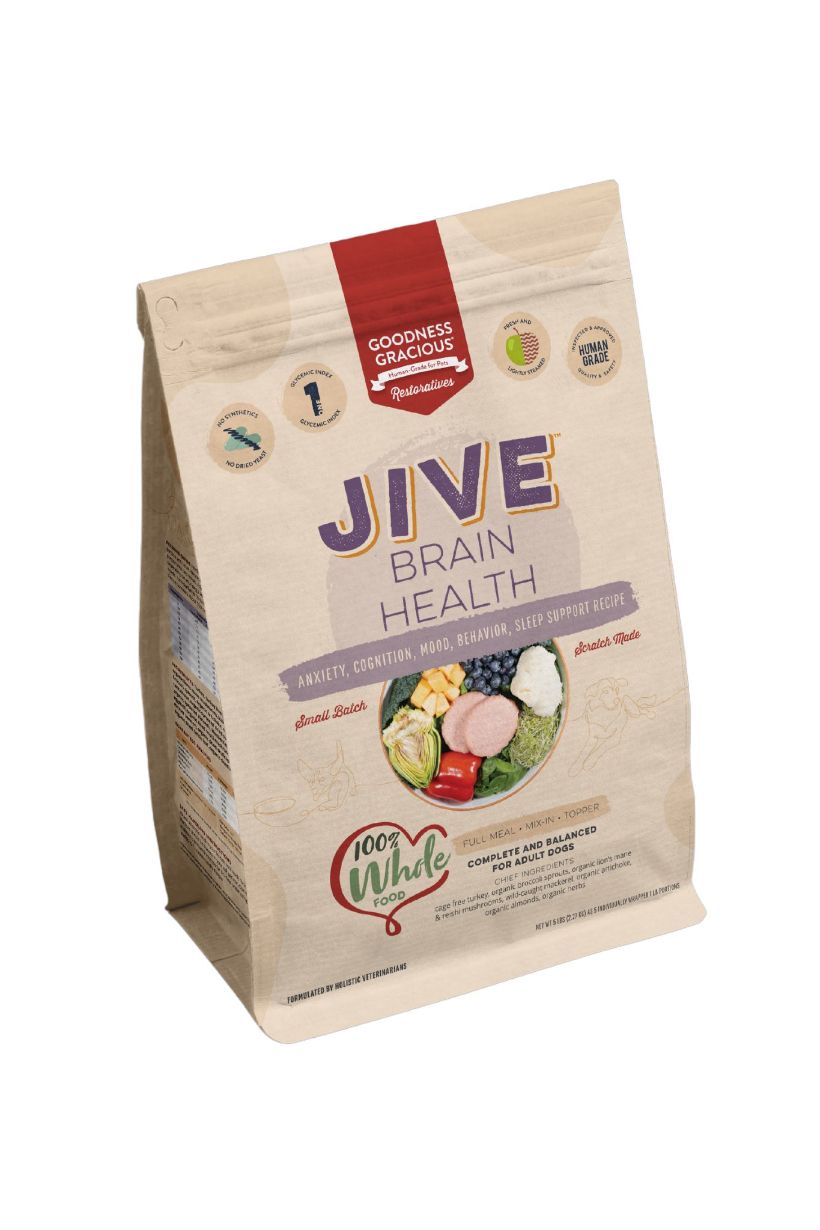Feeding Our Dog's Lifelong Brain Health

Does Nature or Nurture Drive Cognition, Mood and Behavior?
I have three dogs. If I assigned them character names from Peter Pan they would be: Tink, The Pan and Smee.
If they were soda pop brands they would be: Squirt, Quench, and Chug.
Oh, to be a dog. The ideas, impulses and emotions that run through those beautiful brains! Chase squirrel. Dig hole. Cheese! Kisses. Cuddles. Puddles! Nap. Pounce. Shake. Grrrrr.
Is it nature or nurture that gives us personality traits, quirks, and playtime preferences?
Two of my three dogs are biological sisters. Why is one a cool customer during thunderstorms when the other heads for her hideout? Why does The Pan – a confident gamesome girl – get spicey around a select few dogs?

And the bigger question: How does an aspiring Super Mom help her dog be the best version of himself?
Very often when we have a dog with a behavioral issue, we skip over the single most influential thing affecting his thoughts, feelings and actions Our first reaction often is to reach for a trainer or a drug like Prozac, which affects serotonin levels, or gabapentin, which affects GABA levels.
Both serotonin and GABA regulate brain function. They are neurotransmitters made by gut microbes, and are tightly regulated by the gut. The first place we should look when we see behavior, mood or cognitive issues is the gut.
The Gut Brain Axis
Like us, our dogs have brain cells that exist outside the brain. The gut is comprised of 50 - 100 million neurons. As many braincells are in the spinal cord as are in the gut. The health of the gut is what drives mood.

The gut-brain axis is a bi-directional link between the gut and the brain. It refers to how the gut and what we put into it affects cognition, mood or behavior; and how our brain affects the behavior of our digestive system.
The vagus nerve is the main neurologic highway between the gut and the brain. It runs from the brain stem to the abdomen. Ninety percent of the traffic along the vagus nerve travels from the gut up to the brain. Only 10% is our brain telling our gut what to do. (Butterflies when we’re nervous is a good example of that.)
The vagus nerve communication system regulates stress, depression, anxiety, how we calm down after trauma, cognition and the immune system because it relates to inflammation.
Food Transforms into Fuel and Signals
Our digestive system is our guts from mouth to butt. Food goes in and is transformed into packets of fuel and signals. These packets are used in the gut and transported through our vascular, nervous and endocrine systems. Fuel includes substances like glucose and fatty acids. Signals are compounds like hormones and neurotransmitters, antigens and toxins, vitamins and antioxidants. Amino acids can be both fuel and signals.
The gut microbiome is the most densely populated ecosystem on Earth. It is made up of trillions of wildly diverse microorganisms operating as a highly efficient bioreactor shaping our moods, thoughts, feelings and beautiful uniqueness.

Like our dogs, the organisms in the gut microbiome have species-appropriate nutrition. Their ideal food comes from plants and mushrooms. They digest fiber and phytonutrients. The bioactive metabolites are then transported throughout our bodies aiding not only our brains, but detoxification, cancer prevention, immunity and more.
When appropriately fed a broad array of vegetables, fruits and mushrooms, the core gut-based microorganisms like Lactobacillus, Bacteroidetes and Bifidobacterium make and influence most of the circulating neurotransmitters and hormones (neuropeptides) in our bodies.
These include substances like:
- Serotonin – a neurotransmitter that also acts as the “happy hormone” regulating mood, sleep and digestion.
- GABA – the anti-stress / anti-anxiety neurotransmitter.
- Histamine – a neurotransmitter influencing wakefulness, eating behavior and motivation.
- Acetylcholine which is used in memory making, recall, motor function and gut motility.
- Dopamine – a biochemical that helps us decide if the work is worth the effort. It encourages us to take action and then to feel pleasure with the accomplishment.
Feeding the Brain
Eating a high protein, moderate fat, low starch, phytonutrient rich diet also promotes a healthy vascular system – which is critical for brain health. Why?
The brain makes up about 2% - 4% of body mass but accounts for 50% of glucose and 20% of oxygen usage in the body. The brain does not have the ability to store these substances, so it needs a constant supply which it gets from a healthy blood flow. When blood does not flow well, the brain is deprived of its nutrient delivery and waste disposal systems. Toxins accumulate which damage the brain.
There are tiny blood vessels in the brain that dead end in the white matter central part of the brain. Destruction of these tiny blood vessels from prolonged high carb and high fat diets starts to manifest as mild recall issues, walking and movement problems, deficits in motivation and interest, and poor bladder control. Continual damage can progress to more severe forms of cognitive dysfunction, strokes and dementia.

So what does a brain health diet look like? An amped up ancestral diet model is a good place to start.
An ancestral diet for dogs starts with 49% of calories from protein, 44% from fat, and 7% from carbohydrate. Focusing on lean proteins with generous helpings of leafy and cruciferous veggies, mushrooms and a few fruits will support a healthy gut microbiome and good vascular function without contributing starchy calories to the diet.
Remember fiber has no calories. This means leafy and cruciferous veggies can comprise 30% of the weight of the ingredients in the bowl but only about 5% of calories. Three of my favorite phytonutrients for brain health are lutein, zeaxanthin and beta carotene. These are carotenoids found richly in kale, spinach, broccoli, carrots, sweet potato, Swiss chard, collards, asparagus and egg yolk.
A Recipe for Brain Health
Below is a good recipe for brain health. It focuses on brain-boosting plant derived nutrients like carotenoids and inositol; and healthy levels of vitamin D (a neurotrophic hormone!), vitamin E, magnesium, choline, and tryptophan (a precursor to serotonin).
All veggies should be either lightly steamed or finely pureed in a Vitamix® for optimal digestibility. Avoid cooking the ground hemp seeds (or hempseed butter) and wheat germ oil. And remember, it is best to feed food that is at least room temperature to slightly warm.
This recipe is formulated to be complete and balanced for adult dogs. It makes approximately eight pounds of food, and contains about 33 calories per ounce. It can be served either raw or lightly steamed.

A whopping 55% of the calories come from protein, 41% from fat, and only 3.6% from carb.
And for those days when you don't feel like DIY-ing it, Goodness Gracious makes JIVE, a restorative recipe supporting cognition, mood and behavior in dogs with therapeutic levels of medicinal mushrooms and herbs, and purposefully chosen 100% whole food ingredients.
Enjoy!

|
Feeding Guide |
||
|
Weight of dog (in lb) |
Couch Potato (in oz) |
Wonder Dog (in oz) |
|
10 |
8 |
10 |
|
20 |
13 |
17 |
|
30 |
18 |
24 |
|
40 |
23 |
29 |
|
50 |
27 |
35 |
|
60 |
31 |
40 |
|
70 |
35 |
45 |
|
80 |
38 |
49 |
|
90 |
42 |
54 |
|
100 |
45 |
58 |
|
Ingredient: |
Amount: |
|
Turkey thighs (boneless & skinless) |
4 lb |
|
Sardines (canned and packed in water without salt) |
8 oz |
|
Turkey liver* |
8 oz |
|
Spinach |
8 oz |
|
Eggs with the shell (finely grind the shell) |
8 oz (about 4 eggs) |
|
Okra (usually available in the frozen food aisle) |
8 oz |
|
Broccoli (or green beans) |
4 oz |
|
Sweet Potato** (or carrots) |
4 oz |
|
Hemp seeds (finely ground) or hemp seed butter |
4 oz |
|
Cantaloupe |
4 oz |
|
Oysters (canned and packed in water) |
2 oz |
|
Organic wheat germ oil |
1 oz |
|
Kelp powder |
2 grams |
* If you cannot find turkey liver you can omit it or substitute chicken liver.
** Always cook sweet potato, even if your dog is raw fed.
|
Feeding Guide |
||
|
Weight of dog (in lb) |
Couch Potato (in oz) |
Wonder Dog (in oz) |
|
10 |
8 |
10 |
|
20 |
13 |
17 |
|
30 |
18 |
24 |
|
40 |
23 |
29 |
|
50 |
27 |
35 |
|
60 |
31 |
40 |
|
70 |
35 |
45 |
|
80 |
38 |
49 |
|
90 |
42 |
54 |
|
100 |
45 |
58 |


